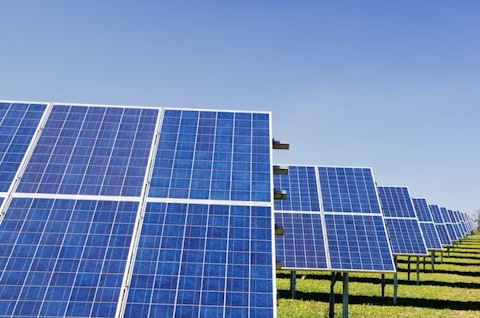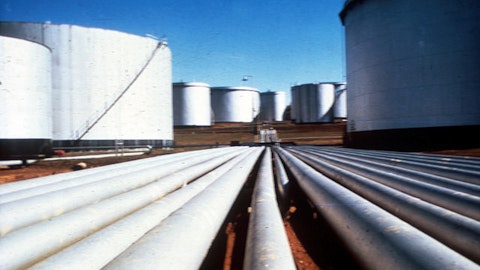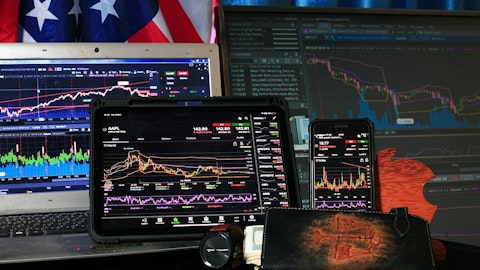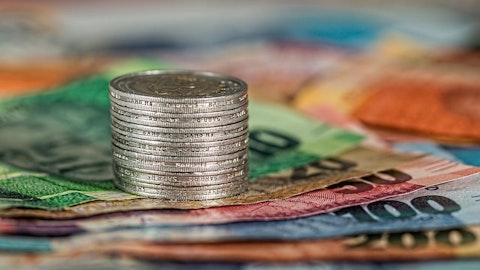Enterprise Products Partners L.P. (NYSE:EPD) Q4 2022 Earnings Call Transcript February 1, 2023
Operator: Good day, and thank you for standing by. Welcome to the Q4 2022 Enterprise Products Partners L.P. Earnings Conference call. At this time, all participants are in a listen only mode. After the speaker’s presentation, there will be a question and answer session . Please be advised that today’s conference is being recorded. It is now my pleasure to introduce Vice President of Investor Relations, Randy Burkhalter.
Randy Burkhalter: Thank you, Andrew. Good morning, everyone, and welcome to the Enterprise Products Partners Conference Call to discuss fourth quarter 22 earnings. Our speakers today will be Co-Chief Executive Officers of Enterprise’s General Partner, Jim Teague and Randy Fowler. Other members of our senior management team are also in attendance for the call today. During this call, we will make forward-looking statements within the meaning of Section 21E of the Securities Exchange Act of 1934 based on the beliefs of the company, as well as assumptions made by and information currently available to Enterprise’s management team. Although management believes that the expectations reflected in such forward-looking statements are reasonable, it can give no assurance that such expectations will prove to be correct.
Please refer to our latest filings with the SEC for a list of factors that may cause actual results to differ materially from those in the forward-looking statements made during this call. And with that, I’ll turn the call over to Jim Teague.
Jim Teague: Thank you, Randy. At our Analyst Meeting last year, we ended the meeting with all senior management, including Miranda, onto the front to take questions. Becca Followill at the time with US Capital Advisors asked me, what I’d like to see in our future. My answer was that I was tired of eights, I’d like to see a nine. Meaning that I was tired of our adjusted EBITDA starting with an eight, I’d like to see it start with a nine. Some folks took that as guidance, which it wasn’t, as at the time, I didn’t think it was possible. Once we returned to the office, I was visiting with Tug Hanley, kicking around the idea of creating a company wide goal of a nine. Doug said, let’s call it Project 9. So Tug was immediately appointed Chairman of the Project 9 initiative.
Tug was joined by 12 others to lead the effort, one of whom Rick Rainey, implemented an internal communications campaign designed to maintain our focus on Project 9 throughout the year with a poster themed around the Starship Enterprise, stating that we can only go where Enterprises never gone before. Tug Hanley, Yvette Longonje, and Daniel Boss introduced the initiative via a company wide webcast, and Starship Enterprise posters were sent to locations throughout the company. The prize was if we made $9 billion adjusted EBITDA, every employee up to and including senior directors would receive 3,000. And if we exceeded 9.3, they would receive 5,000. It was made clear that there would be no safety shortcuts. And very proud to report today that our core values for safety were reinforced in 22 with another year of our best year ever for safety performance with a 0.33 total recordable incident rate.
Also, we had zero lost time injuries in our trucking division where they logged something around 20 million miles for the year. We also emphasized that to achieve Project 9, we would not defer maintenance, pipeline integrity, mechanical integrity or anything we would ordinarily do. In other words, no smoke in mirrors. Our message was that no matter your job, you can always do it better. Through webcast, town halls and safety meetings, we encouraged our employees to come up with ideas that would help realize the success of Project 9. We asked them to share ideas and success stories. We received almost 200 success stories that resulted in something around $280 million toward Project 9 success. A couple of examples is we maximized MTBE production blending isobutylene and through the increasing MTBE production by a couple of thousand barrels a day.
Distribution, operations, commercial and our big data group work to find a way to adjust fractionation set points to increase throughput at our Mont Belvieu Complex. Project 9 gave every enterprise employee a common goal to boldly go where Enterprise has never gone before. For our folks that listen in on this call, when there is a number, albeit through your hard work, creativity, finding ways to do your job better and teamwork, we made $9.309 billion of adjusted EBITDA. So every employee up to and including Senior Director will be receiving $5,000. We had so much fun with this. And we decided we are going to have Project 9.3 for 2023. Again, don’t take it as guidance, because nothing is automatic, especially in this environment. As to numbers, we generated $7.8 billion of distributable cash flow in 2022 compared to $6.6 billion and 21 providing 1.9 times coverage.
We retained $3.6 billion in DCF, which compares to $2.6 billion in 2021. We set 13 financial records and 10 operating records in 2022. Operating results included record and NGL pipeline transportation, ethane exports, total NGL marine terminal volumes, fee based natural gas processing and natural gas pipeline transportation. In our petrochemical sector, we set operating records in propylene production, DIB processing and octane enhancement. In barrels of oil equivalent per day, Enterprise transported a record 11.2 million barrels a day of oil equivalent in 2022. Major growth for our capital in ’23 in addition to our second PDH, we have four gas processing plants under construction in the Permian and we’re constructing our 12 fractionator in Chambers County and we have expansions in both ethane and ethylene export facilities.
2022 was another volatile year with group trading as high as $120 and as low as $70. NYMEX natural gas traded between $9.50 to $3.50. Natural gas liquids also was no stranger to volatility. Ethane traded between $0.70 a gallon and $0.25 a gallon and propane traded between $1.60 and $0.60. For 2023, we are constructive on crude oil, but much less so on natural gas. Wide gas to crude spreads should lead to US petrochemicals having a very large cost advantage globally. On the supply side start with the fact that volumes from the strategic petroleum reserve provided a whopping 240 million barrels slug of supplies in the global markets most of it from the US. Those barrels are not going to be here in 2023. China seems to be open. IEA estimates Chinese demand will be up by 1 million barrels a day to 16 million by June.

Photo by Zbynek Burival on Unsplash
This accounts for one half of expected global oil demand growth. The IEA also expects demand to hit a record of nearly 102 million barrels a day this year, 3/4 of the growth in non-OECD countries, which is just fine with us as we do have a nice real estate position on the water. One thing we believe there will be continued volatility in 2023, but our experience is volatility leads to opportunities. With that, I’ll turn it over to Randy.
Randy Fowler: All right. Thank you, Jim. Good morning, everyone. Starting off with the income statement. Fourth quarter net income attributable to common unitholders was $1.4 billion or $0.65 per common unit on a fully diluted basis. This compares to $1 billion or $0.47 per common unit for the fourth quarter of 2021. Adjusted cash flow from operations, which is cash flow from operating activities before changes in working capital was $2.1 billion for the fourth quarter of 2022. This is a 16% increase compared to $1.8 billion generated for the fourth quarter of 2021. We declared a distribution of $0.49 per common unit for the fourth quarter of ’22, which is 5.4% higher than the distribution declared for the fourth quarter of the prior year.
The distribution will be paid February 14th to common unitholders of record as of close of business on January 31st. We will evaluate another increase in the distribution midyear in 2023. During the fourth quarter, we repurchased approximately 4.9 million common units at a cost of $120 million. For the entire year, we purchased a total of 10.2 million common units for $250 million. In addition, on a combined basis, our dividend reinvestment plan and employee unit purchase plan purchased 1.7 million and 6.4 million common units during the fourth quarter and for the full year of 2022, respectively. For 2022, we paid approximately $4 billion of distributions to Limited Partners. Together with our buybacks for 2022, Enterprise’s payout ratio of adjusted cash flow from operations was 54% and our payout ratio of adjusted free cash flow was 71% if you exclude the $3.2 billion investment in the acquisition of Navitas Midstream.
Now turning to capital investments. Total capital investments in the fourth quarter of 2022 were $763 million, which included $465 million for organic growth capital projects. $160 million for purchases of pipelines and related assets and $138 million of sustaining capital expenditures. During the quarter, we purchased approximately 580 miles of existing pipeline and related assets that enables us to cost effectively optimize and expand our NGL and petrochemical pipeline system on the upper Texas Gulf Coast. Total capital expenditures in 2022 were $5.2 billion, which included $3.4 billion for the acquisition of Navitas and the purchase of the 580 miles of pipelines, $1.4 billion for investment in organic growth capital expenditures and $372 million of sustaining CapEx. Last quarter, we had estimated $1.6 billion of organic growth capital investments in 2022.
However, approximately $200 million of this investment slipped into 2023. Our major growth capital projects under construction grew from $5.5 billion last quarter to $5.8 billion. The additional $300 million of projects under construction are really attributable to expansions in the scope of our new ethane — ethylene export facility and debottlenecking gathering systems in the Permian. As a result of the $200 million of CapEx slipping from 2022 into 2023 and the above additional opportunities in the Permian, we currently expect our 2023 growth capital expenditures to be approximately in the range of $2.3 billion to $2.5 billion and sustaining capital expenditures are expected to be approximately $400 million. Our total debt principal outstanding was $28.6 billion as of December 31, 2022.
During 2022, we reduced the principal amount of our debt outstanding by $1.3 billion. Assuming the final maturity date of our hybrids, the weighted average life of our debt portfolio is approximately 20 years. Our weighted average cost of debt is 4.5%. And at December 31st, approximately 96% of our debt was fixed rate. Our consolidated liquidity was approximately $4.1 billion at year end and this includes availability under our credit facilities and unrestricted cash on hand. In January, we issued $1.75 billion of senior notes comprised of $750 million of three year notes at a coupon of 5.05% and $1 billion of 10 year notes at a 5.35% coupon. We are appreciative of the strong continued support of our debt investors in this offering. We do not expect to return to the capital markets in 2023.
Adjusted EBITDA was $9.3 billion for 2022 and our consolidated leverage ratio was 2.9 times on a net basis after adjusting debt for the partial equity treatment of our hybrid debt and also reducing by the partnership’s unrestricted cash on hand. As Jim noted in the earnings release, we expect to achieve a major financial milestone in 2023, that is 25 consecutive years of distribution growth. As we looked at the financial attributes of the 65 companies that comprise the dividend aristocrats, these are the bluest of the blue chips. Some have over 60 consecutive years of dividend growth. The overwhelming majority had debt to EBITDA leverage ratios of less than 3.0 times and almost half were below 2 times. To support our financial goals to responsibly grow the partnership and provide our limited partners with a growing and resilient stream of cash distributions over the long term, we believe we have entered into a new era, which it is wise to have a stronger balance sheet than historical norms in the energy industry.
We are seeing our customers in the E&P, refining and petrochemical sectors do likewise. As a result, we are lowering our target leverage ratio from 3.5 times to 3.0 times, plus or minus a quarter of a turn. That is a range from 2.75 times to 3.25 times. And as we’ve noted earlier, our leverage for 2022 we ended at 2.9 times. So we’re in good shape with regard to this new target. We would be willing to temporarily take our leverage ratio above this target zone, if necessary, to complete an acquisition or an organic growth project that is strategic to the partnership. We believe this lower leverage target will be welcomed by our long term oriented investors who value distribution growth and stability. We also believe as more generalist investors consider income producing investments in infrastructure, the combination of Enterprise’ avoidance of double taxation and our history of distribution growth, coverage and lower leverage will make EPD attractive and that they may also start to consider EPD among the blue chips.
With that, Randy, I think we can open it up for questions.
Randy Burkhalter: Thank you, Randy. Andrew, we’re ready to take questions from our participants. I’d like to remind everyone to please limit your questions to one question and one follow-up. Thank you. Go ahead, Andrew.
See also 20 Stocks That Are Aggressively Buying Back Shares and 11 Most Undervalued Blue Chip Stocks To Buy .
Q&A Session
Follow Enterprise Products Partners L.p. (NYSE:EPD)
Follow Enterprise Products Partners L.p. (NYSE:EPD)
Operator: Our first question comes from the line of TJ Schultz with RBC Capital Markets.
TJ Schultz: First question, just on the 580 miles of pipeline and related assets that you purchased last quarter seems like a good price paid for that. If you could just provide more color on what you were able to purchase, how those assets will be integrated into your system? And if there’s any CapEx allocated to that in 2023 that may be driving part of the higher growth capital?
Chris D’Anna: I guess, first off, this is Chris D’Anna. The capital won’t increase or hasn’t increased as a result of that. Secondly, these pipelines are in a valuable corridor, which is going to allow us to optimize both our NGL business and our petchem business and provide other opportunities.
Zach Strait: This is Zach on the NGL side, I think if we look at the price we paid versus the optionality that Chris is describing, I think it made sense for us.
Jim Teague: I think you said capital, Chris, on one of your projects
Chris D’Anna: It also saves some — one of the other projects fairly small capital, it saved us a pretty significant amount of capital in that project.
TJ Schultz: I guess the follow-up is just a general question on capital allocation. You guys clearly continue to maintain plenty of flexibility, strong balance sheet with target debt leverage lower and you already sit there. So I’m just trying to see, do you anticipate any shift to more distribution growth? Is there any more intent on finding some of these acquisition opportunities like you did on the upper Gulf Coast, or how do share buybacks fall in there?
Randy Fowler: TJ, yes, I think between the Navitas deal and then the two deals that we did at the end of 2022, we are interested in asset acquisition opportunities that make sense that can come in and bolt on to our system and get good returns on capital that way. And that’s where the lower leverage gives us flexibility to come in and do these cash transactions to do that. I think over the last, call it the last 18 months, we’ve shown — we’ve sort of completed that pivot to go from an externally funded model to an internally funded model. And we had slowed distribution growth there for about three years or so. And over the last, call it 18 months, we’ve taken that distribution growth back up to about 5% area. So we have increased the pace of distributions.
And then the buybacks, we continue to do that opportunistically. So we feel like we’re in good shape to execute on opportunities that come to us in 2023, 2024. So we feel like we’re sort of checking the box of returning capital and all of the above and also maintaining lower leverage at the same time.
Operator: And our next question comes from the line of Colton Bean with TPH & Company.
Colton Bean: So just on Project 9.3, I appreciate the distinction that it’s an internal goal and not guidance, but two questions there. First, for Jim, has the team ever missed an internal goal? And then secondly, any high level comments as to how you achieve that, mark. It seems like commodity margins maybe a bit of a headwind, but then you have some sizable projects entering service throughout the year.




